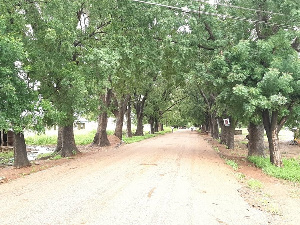Opinions of Monday, 2 October 2023
Columnist: Cameron Duodu
Of trees and human callousnes
Whenever I see a tree being cut down, I feel as if every blow delivered to the tree by an axe or cutlass, has been inflicted on my own body.
I got my relationship with trees from my early years when my father used to make farms out of areas of the virgin rainforest known as the Atewa Range.
The parts of the Range that had not been turned into a “forest reserve” and were therefore accessible to us, stretched from Adadientam (near Kyebi) past Tetteh and Sagyumase, to Asiakwa (my hometown) and thence to Bunso, Nsutem, Osino and Kwabeng, by way of to Saamang and Dwaaso.
The people in all these localities were related through marriage and tradition, and although there were occasional disputes about the unnegotiated crossing of “boundaries" for farming purposes, these were very rare and easy to settle. Indeed, throughout my childhood, I heard of only one land dispute that dragged on and on. The Asiakwa people regarded the instigator of the dispute as a congenital “litigant” It was insinuated that the guy was slightly touched in the brain. This was partly because he used to talk to himself while walking up and down our main streets: “The land is at the junction between Saamang and Dwaaso!” he would mutter to no one in particular. “I shall worry them till I wring it back from them!”.
He was the only Asiakwa resident who had ever set foot in the “High Court” in Accra (it was additionally whispered.) Of course, we kids didn’t understand anything about “High Courts”, but the fact that I still remember so many of the details about him to this day is evidence that he made a huge impression on us. (Indeed, lest I forget: he was reputed to possess a fearsome, very well-sharpened sword of the ‘Zabrama’ type (not common in Southern Ghana but popular in the North) which he secretly kept in his house. This story was one of those which contained their inherent proof, for who would be stupid enough to ever provoke him to go and fetch The Sword?) I am sure it was all in people’s imagination; for in our area, legends abounded.
Well, living in a place like that, my mind filled with imaginary creatures whenever we went into the forest to tend our farms. I had been told that trees “talk back” if you throw a rock at them. So I would pick myself a spot where the land was naturally inclined downhill and throw the rocks from there at selected trees.
“Toh!.....Toh….! Toh!”.... I would throw the stones. And I would prick my ears to hear the “feedback”. There was none, of course, but my mind would tell my ears that the trees said things like: “If you want to catch grasscutters, you must put pieces of unpeeled cassava in front of the snare.” Or “If it’s pheasants you want, your bait must be cocoyam cut into small pieces!”
I would play this game with the trees for minutes on end, until my father chanced upon me, whereupon he would order me to go and do some weeding under the vegetables my mother had planted. My inability to play my game with the trees undetected created a special bond between me and them. I would promise them silently to come back and learn more from them. Later – on days when my father would not be around!
As I say, ever since then, I’ve hated it when I see people cutting down trees. Neem and mango trees were ruthlessly mown down from the pavements of Accra to make way for market women’s containers and kiosks; huge odum, wawa, afromosia and mahogany trees and other precious timbers mindlessly felled to near-extinction, from Ghana’s wonderful forests, and shipped abroad. We are, of course, also destroying more trees through our tolerance of ruthless galamsey.
So I’ve been admiring the parks of England, South Africa and Zimbabwe (where jacaranda trees abound) and spend hours in parks whenever I am able to visit those countries. Imagine my utter horror then, when I read the following report the other day:
QUOTE:
Britain's Sycamore Gap tree, a much-loved landmark… [had been] cut down…. in what police called a "deliberate act of vandalism". Police said they had arrested a 16-year-old male in connection with the felling of the statuesque sycamore [that grew] in northern England…. in the landscape alongside Hadrian's Wall.
It was also known as the 'Robin Hood Tree' after featuring in the 1991 film "Robin Hood: Prince of Thieves".
Photographs showed the tree, estimated to be hundreds of years old and voted "English Tree of the Year" in 2016, lying on its side across the wall, next to [its] freshly-cut stump.
"This is a world-renowned landmark and the events of today have caused significant shock, sadness and anger throughout the local community and beyond," said Superintendent Kevin Waring, of Northumbria Police.
"An investigation was immediately launched following this vandalism, and this afternoon we have arrested one suspect. '' The [British] National Trust, who look after the site alongside Northumberland National Park, said it was "shocked and desperately saddened".
Entertainment










